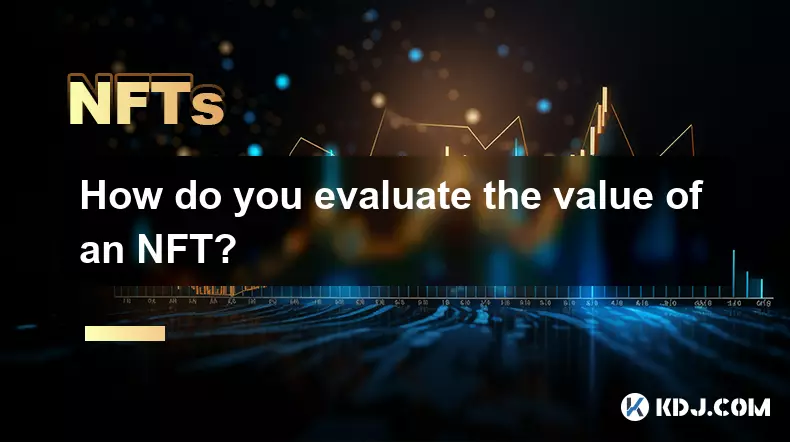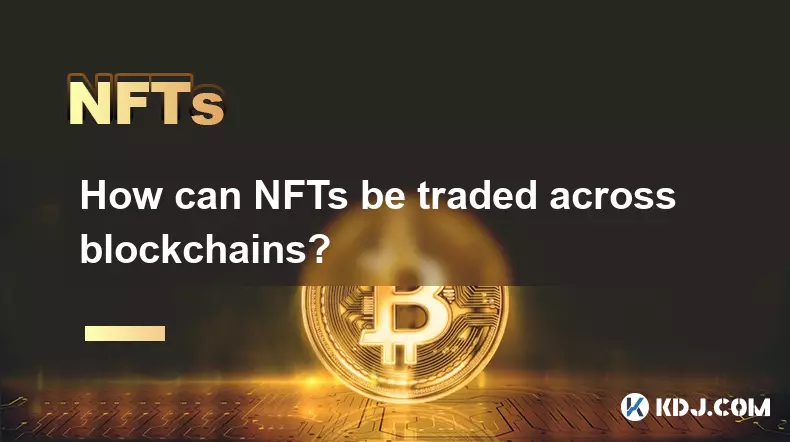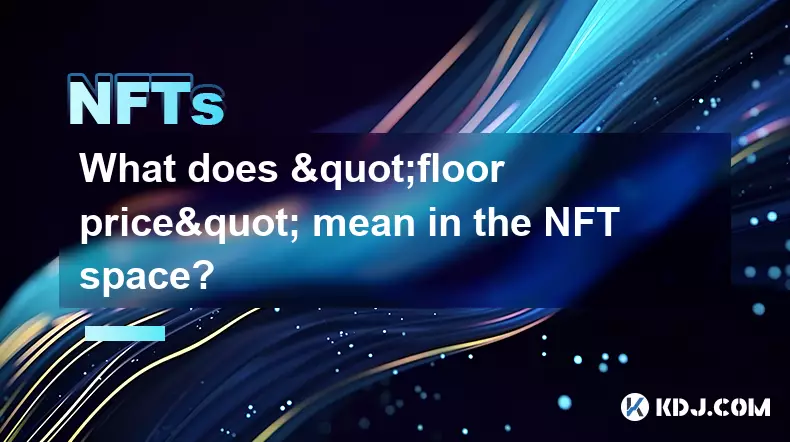-
 bitcoin
bitcoin $109523.663807 USD
-0.13% -
 ethereum
ethereum $4019.526508 USD
2.06% -
 tether
tether $1.000482 USD
0.00% -
 xrp
xrp $2.776815 USD
0.18% -
 bnb
bnb $958.942396 USD
0.12% -
 solana
solana $204.294698 USD
3.84% -
 usd-coin
usd-coin $0.999693 USD
0.00% -
 dogecoin
dogecoin $0.232115 USD
2.09% -
 tron
tron $0.338028 USD
0.84% -
 cardano
cardano $0.790920 USD
1.50% -
 hyperliquid
hyperliquid $44.871443 USD
5.60% -
 ethena-usde
ethena-usde $1.000322 USD
0.04% -
 chainlink
chainlink $21.034165 USD
2.60% -
 avalanche
avalanche $28.794831 USD
-0.54% -
 stellar
stellar $0.360466 USD
1.24%
How do you evaluate the value of an NFT?
An NFT’s value hinges on scarcity, unique traits, creator reputation, community strength, and verifiable ownership history, all supported by transparent metadata and on-chain data.
Sep 21, 2025 at 09:18 am

Evaluating the Rarity and Uniqueness of an NFT
1. The scarcity of an NFT plays a central role in determining its market value. Projects that issue limited editions or one-of-a-kind digital assets often command higher prices due to constrained supply.
2. Metadata attributes such as color schemes, accessories, background elements, or animation layers contribute to perceived rarity. Collectors frequently refer to trait rarity scores generated by algorithms to assess how uncommon specific features are within a collection.
3. Some NFTs are part of generative art series where each piece is algorithmically created. In these cases, certain combinations occur less frequently, making them more desirable.
4. Provenance also matters—NFTs minted directly by well-known creators or early adopters in a project may carry additional weight simply because of their origin story.
5. A verifiable history of ownership, especially if linked to prominent figures in the crypto space, can significantly elevate an NFT’s desirability and price.
Assessing Creator Reputation and Community Engagement
1. The identity and track record of the artist or development team behind an NFT collection influence buyer confidence. Established names with prior successful drops tend to attract stronger demand.
2. Active communities on platforms like Discord, Twitter, and Telegram serve as indicators of sustained interest. High engagement levels suggest ongoing support for the project beyond initial hype.
3. Regular updates, roadmap execution, and transparent communication from the team reinforce trust. Projects that deliver utility or evolve over time maintain relevance longer than static offerings.
4. Collaborations with mainstream brands, celebrities, or other blockchain projects amplify visibility and lend credibility, often resulting in increased valuation.
5. An engaged, loyal community can act as a self-sustaining ecosystem that drives trading volume and supports floor prices during market downturns.
Analyzing Market Data and Trading Activity
1. Secondary market sales data provides concrete insights into real-world demand. Platforms like OpenSea, Blur, and LooksRare offer analytics on recent transactions, bid activity, and listing trends.
2. Floor price—the lowest current asking price for any item in a collection—is a key benchmark. Sudden spikes or consistent upward movement indicate growing confidence among holders.
3. Trading volume over time reveals momentum. Collections with steady or increasing volume demonstrate active participation, while declining numbers may signal waning interest.
4. Whale activity—large purchases or strategic holdings by major investors—can shift market perception. Monitoring wallet addresses associated with influential collectors offers clues about institutional-grade interest.
5. On-chain metrics such as holder distribution, sell pressure, and average holding duration provide deeper context beyond surface-level price movements.
Frequently Asked Questions
What role does blockchain type play in NFT valuation?The underlying blockchain affects security, transaction costs, and accessibility. Ethereum-based NFTs often carry prestige due to network reliability and wide adoption, though alternatives like Solana offer lower fees and faster transactions, appealing to different user bases.
Can utility increase an NFT’s worth?Yes. NFTs tied to tangible benefits—such as access to exclusive events, membership privileges, in-game items, or royalty shares—tend to hold value better than purely aesthetic pieces. Utility embeds functional demand alongside speculative appeal.
How do scams impact NFT pricing?Fraudulent projects or rug pulls erode trust across the ecosystem. When high-profile scams emerge, they trigger broader skepticism, leading to reduced spending and downward pressure on legitimate but lesser-known collections.
Is metadata permanence important for value?Absolutely. If an NFT's visual or descriptive data is stored off-chain without proper safeguards, it risks becoming inaccessible—a scenario known as 'link rot.' NFTs with fully decentralized storage (e.g., IPFS or Arweave) are considered more secure and thus more valuable.
Disclaimer:info@kdj.com
The information provided is not trading advice. kdj.com does not assume any responsibility for any investments made based on the information provided in this article. Cryptocurrencies are highly volatile and it is highly recommended that you invest with caution after thorough research!
If you believe that the content used on this website infringes your copyright, please contact us immediately (info@kdj.com) and we will delete it promptly.
- Whales, Trump Coin, and Crypto: A New York Minute on What's Hot (and What's Not)
- 2025-09-27 10:25:17
- SWIFT Tests On-Chain Messaging with Linea: A New Era for Global Finance?
- 2025-09-27 10:25:17
- BullZilla Crypto Presale: Surging Through the Meme Coin Jungle
- 2025-09-27 11:05:15
- Binance Coin, WLFI, Crypto Presales: Decoding 2025's Hottest Trends
- 2025-09-27 10:45:15
- Bitcoin, Gold, Stocks: Navigating the Shifting Sands of Investment in 2025
- 2025-09-27 11:05:15
- Bitcoin, Cardano, and Crypto Presales: Is BullZilla the Next Big Thing?
- 2025-09-27 11:10:01
Related knowledge

How can I determine the authenticity of an NFT project?
Sep 23,2025 at 05:18pm
Understanding the Project Team and Their Background1. Research the identities of the team members behind the NFT project. Verified social media profil...

What's the difference between NFTs and traditional collectibles?
Sep 19,2025 at 12:55pm
Digital Ownership and Provenance1. NFTs are built on blockchain technology, which ensures transparent and immutable records of ownership. Every transa...

How can NFTs be traded across blockchains?
Sep 19,2025 at 12:00pm
Understanding Cross-Chain NFT Trading1. Non-fungible tokens (NFTs) are digital assets that represent ownership of unique items on a blockchain. Origin...

How is NFT rarity calculated?
Sep 18,2025 at 07:54pm
Understanding NFT Rarity Metrics1. NFT rarity is determined by analyzing the uniqueness of individual traits within a collection. Each NFT typically c...

What does "floor price" mean in the NFT space?
Sep 22,2025 at 06:36am
Floor Price: A Core Metric in the NFT Marketplace1. The term floor price refers to the lowest current asking price for any item within a specific NFT ...

How do NFTs help content creators?
Sep 18,2025 at 08:00am
NFTs Empower Creators with Ownership and Monetization1. NFTs provide content creators with verifiable ownership of their digital works, ensuring authe...

How can I determine the authenticity of an NFT project?
Sep 23,2025 at 05:18pm
Understanding the Project Team and Their Background1. Research the identities of the team members behind the NFT project. Verified social media profil...

What's the difference between NFTs and traditional collectibles?
Sep 19,2025 at 12:55pm
Digital Ownership and Provenance1. NFTs are built on blockchain technology, which ensures transparent and immutable records of ownership. Every transa...

How can NFTs be traded across blockchains?
Sep 19,2025 at 12:00pm
Understanding Cross-Chain NFT Trading1. Non-fungible tokens (NFTs) are digital assets that represent ownership of unique items on a blockchain. Origin...

How is NFT rarity calculated?
Sep 18,2025 at 07:54pm
Understanding NFT Rarity Metrics1. NFT rarity is determined by analyzing the uniqueness of individual traits within a collection. Each NFT typically c...

What does "floor price" mean in the NFT space?
Sep 22,2025 at 06:36am
Floor Price: A Core Metric in the NFT Marketplace1. The term floor price refers to the lowest current asking price for any item within a specific NFT ...

How do NFTs help content creators?
Sep 18,2025 at 08:00am
NFTs Empower Creators with Ownership and Monetization1. NFTs provide content creators with verifiable ownership of their digital works, ensuring authe...
See all articles










































































